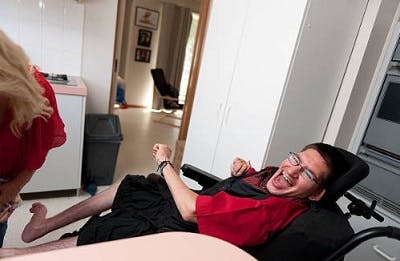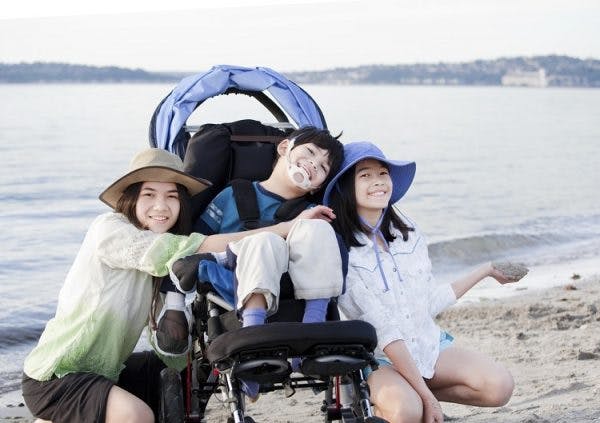Incontinence (difficulties controlling bowel and bladder movements) in children with cerebral palsy is very common.
Most individuals with cerebral palsy eventually learn to avoid bowel and bladder-related accidents, but at a slower rate than the general population.
This article will explain why people with cerebral palsy may take longer to achieve continence and how to manage incontinence.
Cerebral Palsy and Incontinence
One of the defining characteristics of cerebral palsy is abnormal muscle tone.
Spasticity is when your muscles involuntarily contract, resulting in prolonged periods of high muscle tone.
When the muscles in your bowel or bladder don’t contract, waste is not pushed out. Therefore, waste is retained, which can cause urinary tract infections or constipation.
Additionally, some individuals with cerebral palsy have a neurogenic bladder. This is when there is an interruption in communication from the central nervous system to the bladder. This may cause either retention or incontinence of urine.
For example, when the detrusor (the muscle that makes up the wall of the bladder) contracts involuntarily, the bladder can only hold a little bit of urine and leaking occurs.
Factors that Affect Incontinence in Cerebral Palsy

Other cerebral palsy-related factors that can cause incontinence include:
1. Severity of Motor Impairments
Generally, the more severe your motor impairments, the more likely one is to have urinary incontinence.
Those with higher Gross Motor Function Classification System (GMFCS) levels have less mobility and more extreme spasticity, which increases risk of incontinence.
2. Location of Motor Impairments
Cerebral palsy can affect various areas of the body.
It can affect just the legs, half the body, your entire body, or only 1 limb.
For example, if your child’s arm movements are not affected by CP and they are independently mobile, your child likely can get to a bathroom, perform their own transfers, dress and undress themselves, and perform their own hygiene.
A child with affected functions of all four limbs may not be able to independently get to the bathroom, transfer onto the toilet, or manage their own clothing and hygiene. If someone is not constantly with them, they are more prone to bowel and bladder-related accidents.
Individuals with spastic hemiplegia (when CP only affects one side of their body) are less likely to experience incontinence. It’s believed that neuroplasticity (the central nervous system’s ability to adapt) can influence the “unaffected side to assume more control over the bladder during development.”
3. Intellectual Disability
Intellectual disabilities are an associative condition of cerebral palsy.
Although CP and intellectual disabilities are not directly related, nearly 50% of all individuals with CP have an intellectual disability.
If a child with cerebral palsy has an intellectual disability, they may not be conscious of their bladder filling or what to do when they need to use the bathroom.
4. Communication Skills
Cerebral palsy can affect the muscles around the mouth, making it difficult for individuals to verbally communicate their needs. If a child with CP has limited verbal expression skills and does not use an alternative communication method, such as a communication board, they are unable to communicate when they need to use the bathroom. This becomes an issue for individuals who are unable to use the bathroom without assistance and can contribute to incontinence.
Generally, as long as an individual can express when they need to use the toilet and someone is there to help them as needed, accidents can be avoided.
5. Age
Because many children with cerebral palsy lack full control over their muscles, it may take them longer to develop bladder and bowel management skills.
This study involved 459 individuals with cerebral palsy between the ages of 4-18 and found that 70% of the participants learned how to control their bowel and bladder functions, but at a delayed rate compared to children without cerebral palsy.
Managing Incontinence in Cerebral Palsy

Incontinence can negatively affect one’s quality of life.
It can be a burden to constantly worry about whether you need to use the bathroom or what to do if an accident occurs.
Luckily, there are ways to manage incontinence and minimize the frequency of bowel or bladder-related accidents.
Management for incontinence in individuals with cerebral palsy can include:
Following A Bowel and Bladder Management Program
A bowel and bladder management program involves sticking to a schedule in which you consistently empty your bowels or bladder around the same time every day or so.
This helps create consistency but generally requires you to be conscious of your fluid intake and diet throughout the day. If needed, suppositories or enemas may also be used as part of a bowel management program.
Wearing A Diaper
While wearing a diaper may not be ideal, it’s better to be safe than sorry.
Especially if your child is just starting to follow a bladder/ bowel management program or taking new medications for their incontinence, wearing a diaper or pullup may be a good idea just in case an accident does occur.
Taking Medications
For urinary incontinence, many people will take anticholinergic medications to relax their bladder muscles.
Managing bowel incontinence will typically involve bulking agents, suppositories, or enemas.
Using A Catheter
A catheter is a narrow tube that drains urine from your bladder.
There are two types of catheterization frequently used:
The first is called intermittent catheterization, and it involves inserting the catheter tube every 4-6 hours. This type of catheterization limits the risk of complications such as infection, leaking, and bladder spasms.
The other option is called indwelling catheterization, and it entails wearing a catheter at all times. This option may be ideal for those who do not want to worry about how much they’re drinking and sticking to a schedule.
Getting Botox Injections
Botox can relax the bladder muscles by blocking the nerve signals that cause contractions.
It’s important to keep in mind that the effects of Botox are temporary and generally last 3-6 months.
Undergoing Bladder Augmentation Surgery
Just like its name suggests, bladder augmentation surgery expands the size of your bladder so that it can hold more urine.
This extends the time between trips to the bathroom and decreases frequency of bladder-related accidents.
Pelvic Floor Therapy
Often offered by physical therapists, pelvic floor therapy involves retraining your pelvic floor muscles to reduce the likelihood of incontinence. This may include pelvic floor strengthening exercises (such as Kegels), biofeedback training, and manual techniques.
Understanding Cerebral Palsy and Incontinence
It’s normal for young children to have bowel and bladder-related accidents, but as they get older, it can become problematic.
Symptoms and associative conditions of cerebral palsy like motor impairments, intellectual disabilities, and communication difficulties can contribute to incontinence.
Most children with CP learn how to control their bowel and bladder movements. They just might take a little longer, which is completely fine!
Hopefully, this article helped you better understand how cerebral palsy can affect incontinence and what you can do to manage it. Good luck!











